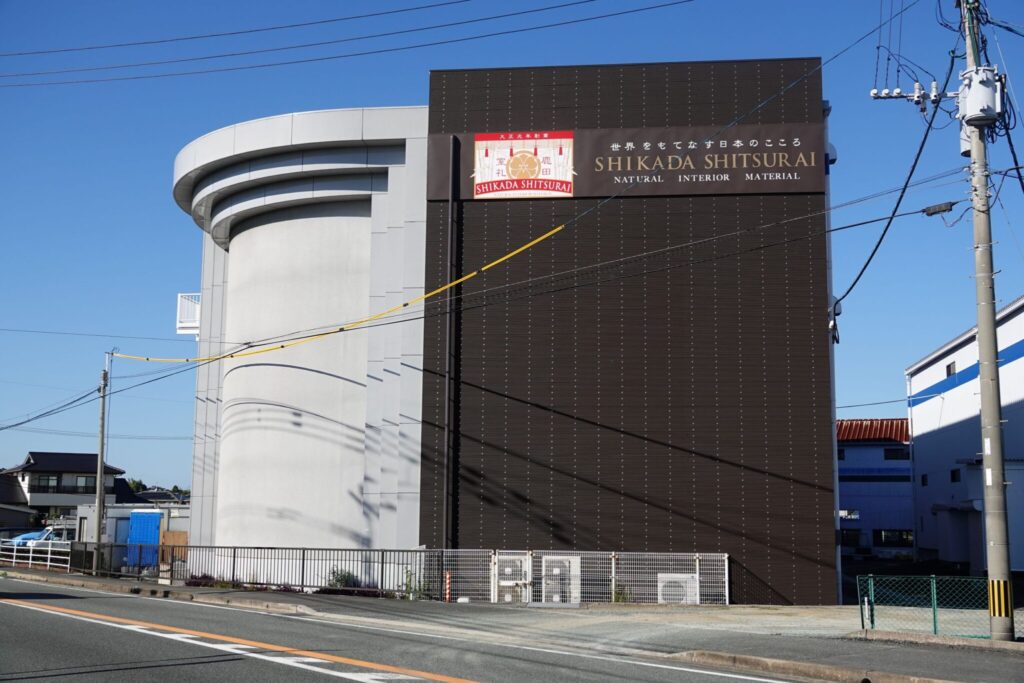SHIKADA SHITSURAI SHOWROOM
– A Next-Generation Hotel Space Made from Sustainable Materials –
More than 110 years after its establishment in 1912, Shikada Sangyo has reopened its showroom as “SHIKADA SHITSURAI SHOWROOM”. This is a hands-on showroom where visitors can experience the decorative use of bamboo texture and designer rattan furnitures. The interior was designed by Kengo Kuma & Associates, who has been using our bamboo texture since around 2009.SHIKADA SHITSURAI offers products that contribute to a sustainable future, such as bamboo screens made of natural materials, accessories made of bamboo texture, rattan furnitures, and interiors made of rattan fabrics. We propose new possibilities of natural materials from here.
The showroom consists of six zones: entrance, lounge, rooms, gallery, store, and laboratory.This article introduces the details of the showroom in six sections.
Facade
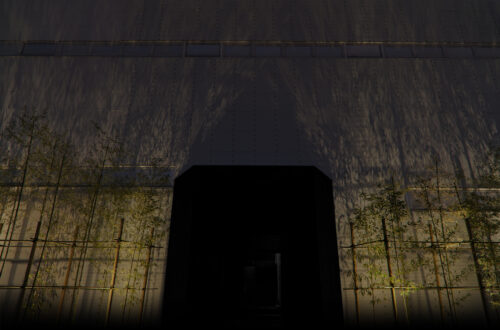
Rare bamboo with natural spots it’s called Unmon Bamboo is used for the facade. Cedar wood is used as the material for the showroom entrance. Unmon bamboo, which stands straight and fresh, are planted along the side of the entrance. As the name suggests, Unmon Bamboo is a rare bamboo whose surface is colored with a brownish-brown speckled pattern like clouds. In conjunction with the renovation of our showroom, we planted a portion of the Unmon Bamboo that we planted at the site of our founding next to the entrance. It is said that it takes about 10 years for the bamboo to become material for sudare (bamboo screens), and we hope that you will enjoy the process of its growth.
Entrance
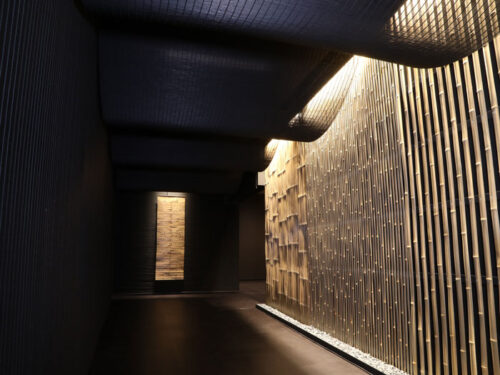
The wall on the right side of the entrance shows artisans’ handiwork, from the creation of the thin bamboo strips that make sudare (bamboo screens) by splitting cut bamboo, to weaving this as sudare woven. On the ceiling, the jet-black bamboo texture forms a graceful arch, creating a design that is both light and taut. It is a light ceiling with a sharp texture emitted by the delicate bamboo texture.
・Round bamboo material with cloud pattern
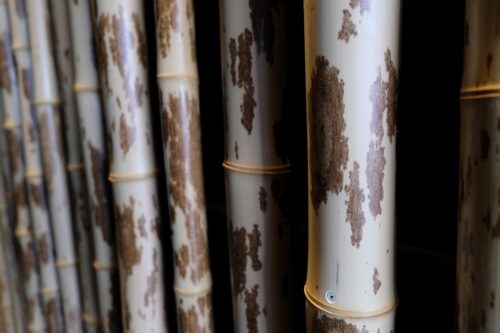
・8 split bamboo material
The bamboo displayed here is hand-split by a hand-split craftsman.
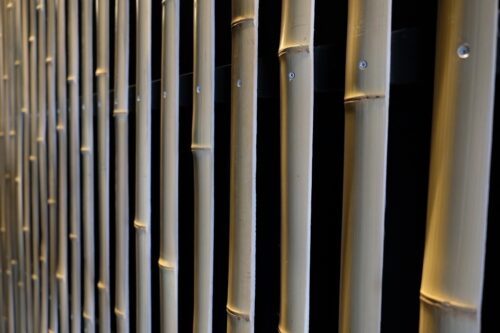
・Three-sliced bamboo bark
The bamboo strips are cut into three pieces so that only the surface skin can be used as bamboo strips.
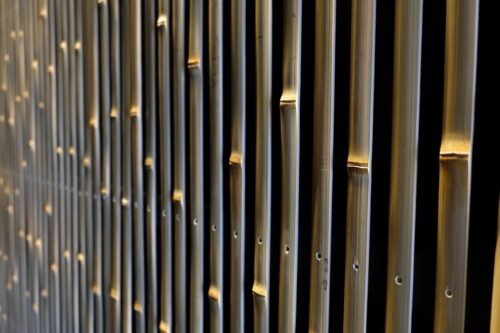
・Bamboo strips
Since it is difficult to install bamboo strips one by one on the wall, bamboo strips are split by hand and woven into a bamboo texture. Bamboo strips are a weaving method in which the density increases as you go deeper.
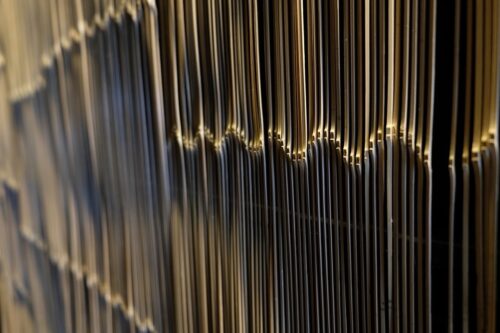
・Character bamboo screens with aligned knots
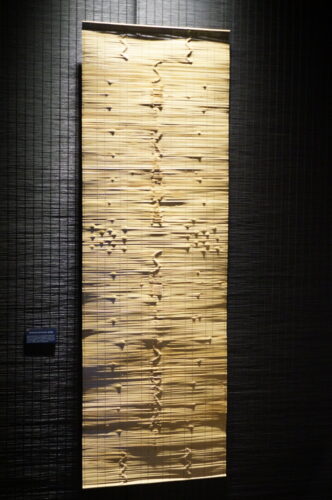 At the far end of the entrance, there is a bamboo screen with the words “SHIKADA SHITSURAI” drawn on it by combining two types of bamboo and aligning the protruding parts of the bamboo joints. The character screen was never thought to be expressed in the conventional way, but this is a highly skilled product made possible by mixing the patterns of the unmon bamboo and the alignment of the bamboo joints. It is the culmination of our craftsmen’s skills.
At the far end of the entrance, there is a bamboo screen with the words “SHIKADA SHITSURAI” drawn on it by combining two types of bamboo and aligning the protruding parts of the bamboo joints. The character screen was never thought to be expressed in the conventional way, but this is a highly skilled product made possible by mixing the patterns of the unmon bamboo and the alignment of the bamboo joints. It is the culmination of our craftsmen’s skills.
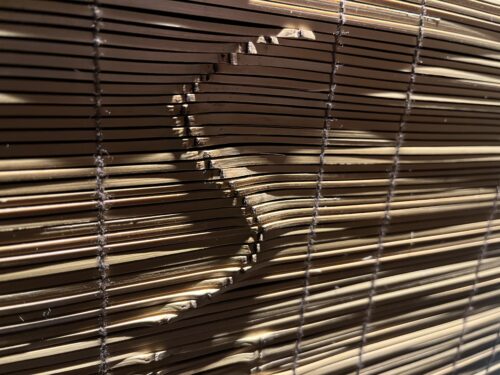
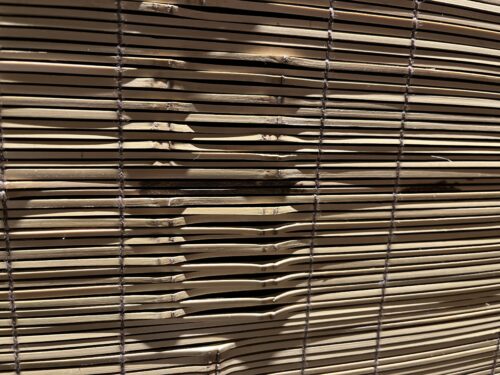
Lounge
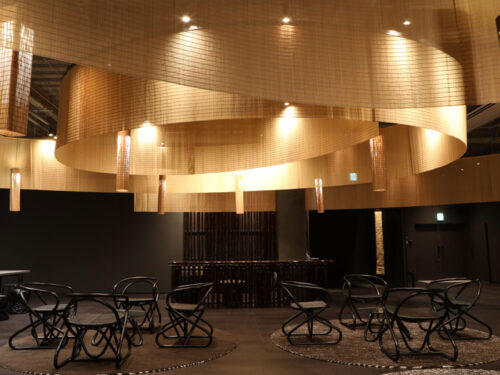
The ceiling of the lounge space is decorated with the graceful curves of bamboo texture. The 1-meter wide, 77-meter long bamboo texture is used vertically to create a dynamic, peaceful, and organic space. The aurora-like design was created by Kengo Kuma, who has actually constructed commercial facilities in Japan and abroad, and has now been upgraded with the addition of a spiral gradations.
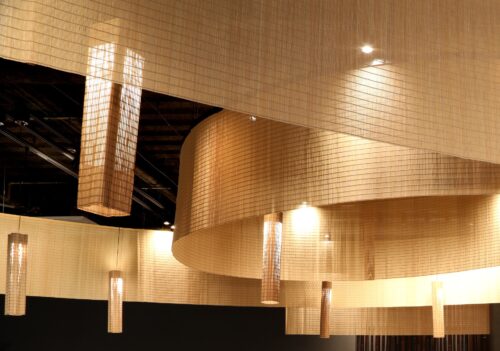
In addition, pendant lights made of bamboo texture are hung from the ceiling.The pendant light shades come in six different designs, offering a wide range of uses for bamboo texture.
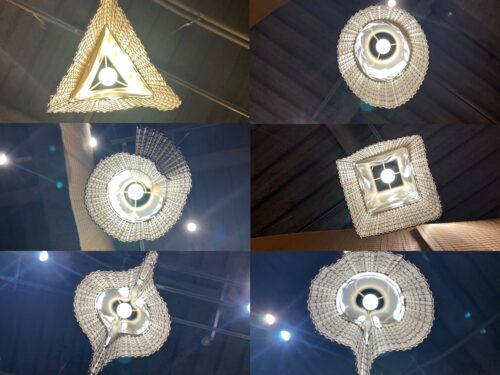
On the right side as you enter the showroom is a counter table. This counter table is made of permeable resin with bamboo rings. It is made by arranging the bamboo slices and pouring the resin in three separate pours to harden it. In the process, the components and paint of the bamboo flow out, giving it a unique texture.
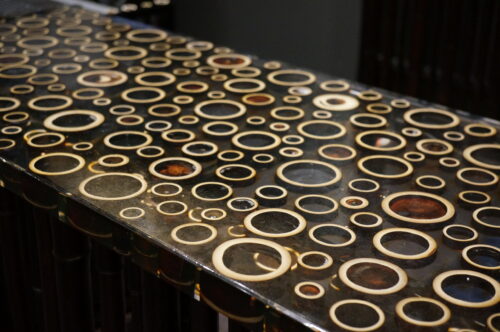
The floor is covered with domestically produced hand-inserted hook wool rugs, which are made using a single-needle electric hook gun and are hammered stitch by stitch.Our company has been dealing in rugs for many years, and this time we paid special attention to the rugs. The brown wool is all natural colored wool, and the border design is inspired by a sudare (bamboo screen).

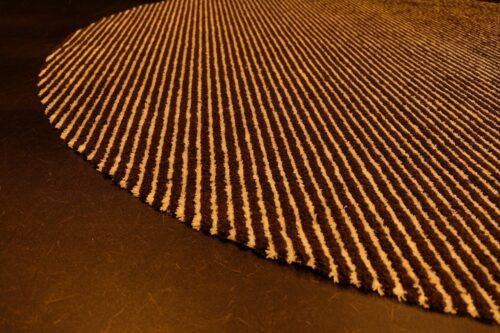
Guest Rooms
There are two hotel guestroom-inspired spaces, embodying the use of bamboo texture in a design that is both Japanese and Western. One is a Western-style room with black as its base color, and the other is a Japanese-style room with natural colors as its base color.
The Western-style room has an entrance door and wall made of bamboo texture, and the same bamboo texture is also used for the TV board and other parts of the room. The shade of the pendant light is made of a different bamboo texture. On the wall, sudare decoration is hung with wire, inspired by paintings. The floor-standing lamps use shades of Yame handmade Japanese paper.

The Japanese-style room is a natural modern space with vertically used bamboo texture and rattan materials. The sliding door fittings are reminiscent of a bamboo screen door. The tokonoma (alcove) is decorated with a hanging Unmon bamboo screen. The alcove ceiling is made of woven bamboo fabric for basket lacquerware, a traditional craft of Kurume City, and the floor is made of woven rattan ajiro. The rug is a recycled rug made from denim scraps, making this a sustainable guest room full of craft techniques.
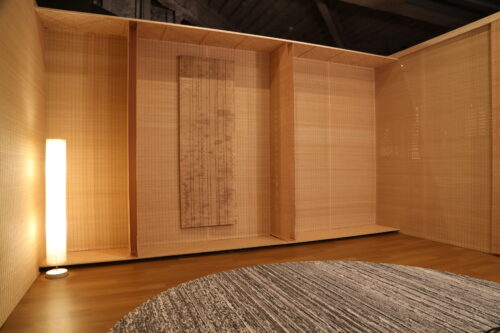
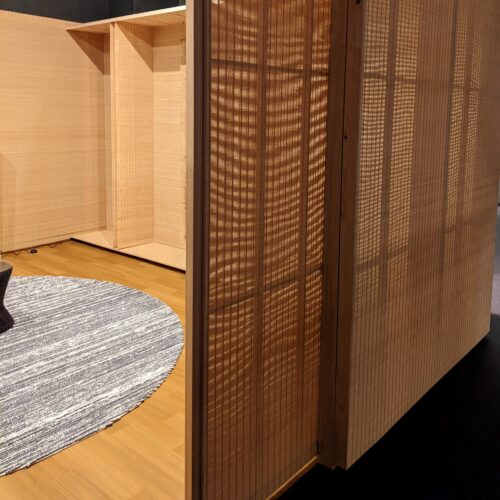
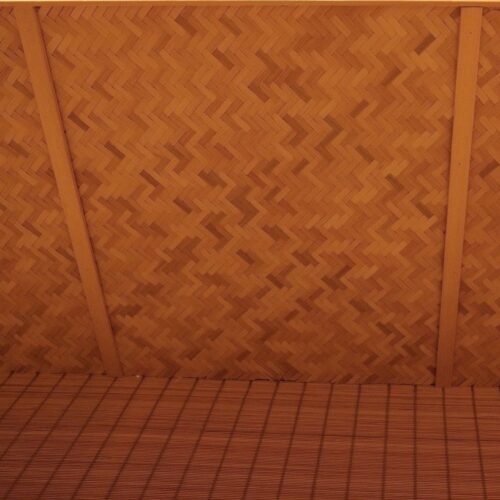 By proposing an interior design that uses bamboo texture for fixtures and wall materials, this space also communicates the new role of bamboo texture, which is made from a natural material called bamboo, for the next generation.
By proposing an interior design that uses bamboo texture for fixtures and wall materials, this space also communicates the new role of bamboo texture, which is made from a natural material called bamboo, for the next generation.
Rattan Furnitures
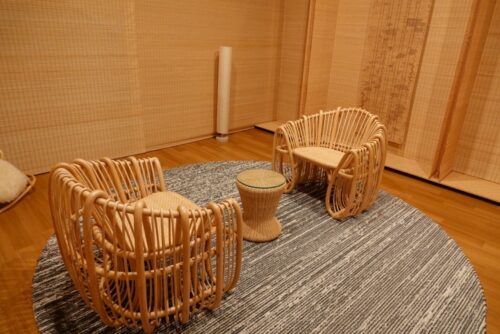
This is the first time that Kengo Kuma has designed furniture made of rattan. The design is like a stroke of a pen, taking advantage of the lightness and durability of rattan material. The product expresses softness, roundness, and beautiful curves.There are 14 types in total, including lounge chairs, armchairs, tables, sofas, stools, and chaise longue.
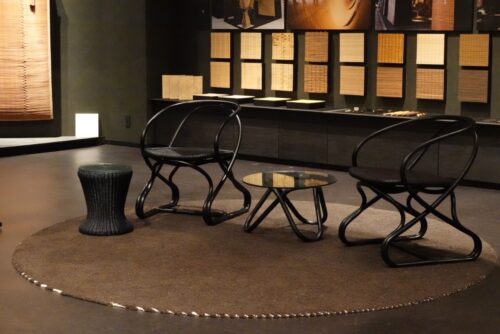
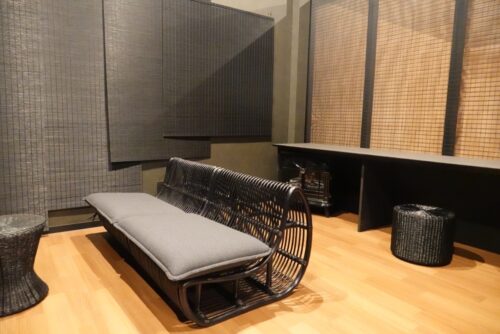
Shop, Gallery, Event Space
[Shop]
This space is made of Japanese cedar wood framing without metal fittings, creating a strong impact. Here you will find a selection of small items made of bamboo and rattan materials suitable for hotel fixtures, handcrafts made by artisans, and environmentally friendly products. Fixtures made of bamboo texture, SDGs-conscious hotel fixtures, regional crafts, and local products including food and beverages will be displayed and sold, and the lineup will be updated as needed. Incorporating these local crafts will not only preserve the environment, but also protect local culture and artisans’ work.
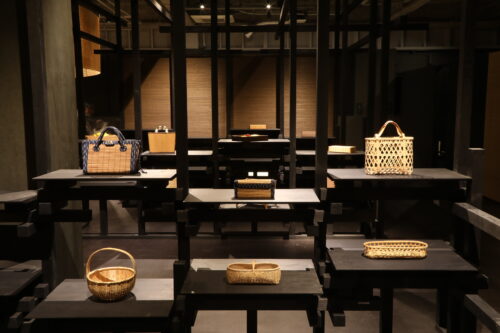
[Gallery]
In the History Gallery space, a sudare (bamboo screen) from the time of the company’s founding and wooden loom, as well as photographs from that time, are on display to give visitors a sense of the long history of the company as it celebrates its 110th anniversary. The four bamboos on display are, in order from the front, Unmon bamboo, Bamboo bark white bamboo, Madake bamboo, and Moso bamboo.
A bamboo screen from the time of the company’s founding

This is a sudare (bamboo screen) produced around the time of the company’s founding in 1912. The edges and tassels were restored 20 years ago, but the bamboo texture and warp threads remain as they were. You can see that the outer weave of green bamboo has changed to a beautiful amber color over the years. If handled carefully, they can be used for many years, and can be repaired and maintained at our factory.
Wooden Loom
This is a wooden frame twisted weave foot loom used in the early Showa period. It has been painted and repaired, and is still usable today. The loom we are currently using is a steel loom. The SUDARE (bamboo screen) machines themselves were already out of production in the 1960s, and we continue to use them while making repairs. Parts that are no longer available are ordered, and maintenance is performed in-house.
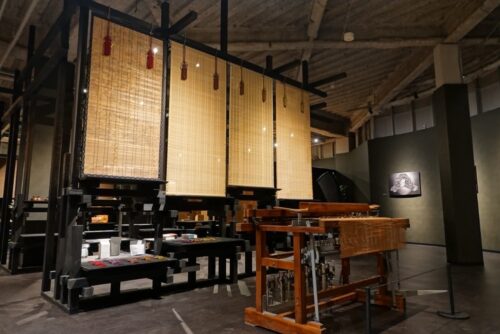
Next to it, Yame SUDARE “Manyo” products, a traditional craft designated by Fukuoka Prefecture, and its component ornaments are on display.
Shikisai textures for commercial/residential spaces are also on display so that visitors can see the colors and transparencies first hand. We have a diverse lineup of about 36 types of bamboo textures, varying in color, weaving method, and thickness of the bamboo strips. Visitors can touch and feel the different textures of all the samples. Elevating mechanisms and parts are displayed on the shelves.
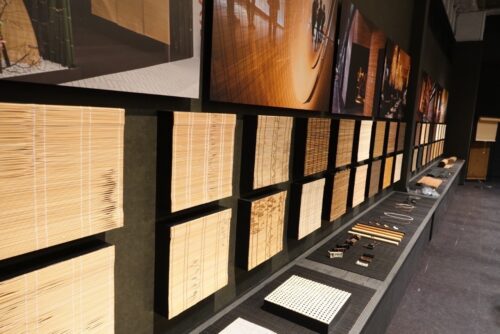
Next to the textures sample space, there is an event space with a screen for business meetings, seminars, and product sales. This space is available for rent.
[Rental Space Rates]
Rent for non-profit events: 1,000 yen per hour
Rent for commercial events: 3,000 yen per hour
Weekly event: 50,000 yen/7 days
Rental space open hours: 10:00 AM to 5:00 PM
In addition, we have a fully-equipped laboratory where you can verify the elasticity and transmissibility of sample fabrics you are interested in. These verification scenes are recorded with images and videos, and information is provided to overseas designers and architects who may not be able to visit the showroom.
What can we do in the laboratory?
・Testing the transmittance characteristics of bamboo textures. Testing the transparency of bamboo textiles with lighting whose illumination and color temperature can be adjusted.
・Twist the textures suspended by a winch to test the angle of rotation.
・The textures was hung on a bar suspended at a height of about 4m to test the degree of expansion and contraction.
・Testing the actual bamboo texture of a large size (1,800 mm wide x 2,000 mm high).
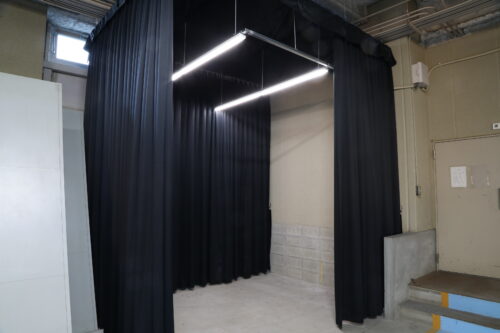
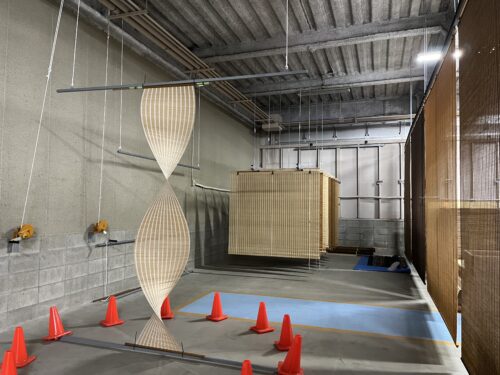
The laboratory where such tests can be conducted is a major feature of this showroom.
“SHIKADA SHITSURAI SHOWROOM” is a hands-on showroom where visitors can experience the decorative uses of bamboo textures, a natural material, as well as designer rattan furnitures. We look forward to your visit.
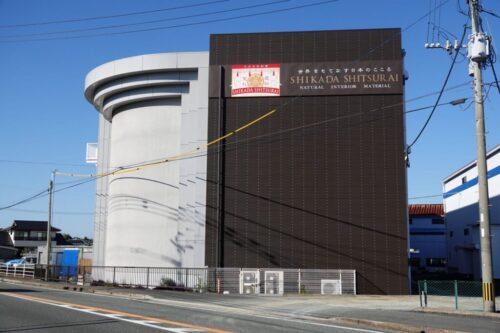
(Exterior of the showroom designed in the image of a bamboo screen)
SHIKADA SANGYO INC.
428 Ota, Hirokawa-cho, Yame-gun, Fukuoka, 834-0114 Japan
Phone: +81-943-32-1141
E-mail: intl@shikada.co.jp
Hours: Weekdays 10:00-17:00 (factory visits until 16:00)


